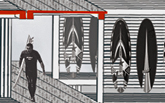

The thesis makes reference to the city of Rhodes and specifically to the western coast of her more northern department. The structure is a wooden navigable jetty which is going to be the extension of one from the tourist axes of region.
With the planning of this structure I attempt to respond to the following questions:
1. How could be create a structure which supplies the temporary needs of the tourism and which will have the ability of modifiability and removal without the influence of the environment and the space of the city.
2. How the structure can mark the changes which are happening to the city because of the tourism (the change of intensity of movements with the end of the tourist season), in level of mapping out.
The proposal is for an ephemeral assembled structure which is setting up only for the summer and as an extension of tourist axis constitutes an exit for these intense movements of the region. The structure concerns the tourism, the recreation and the activities that are expressed at length of the beach as windsurfing and kite boarding.
It is constituted by navigable oblong platforms that are connected from each other with articulations in order to they shape a network from corridors. On this network the bigger percentage of space that is produced is open-air. The closed spaces in the ground floor are intended for lockers room, toilets, stocking space, a small shop for athletic supplies, and stocking space for the athletic equipment that is used by the surfers (surfboards, sails and cloths). The open-air spaces constitute spaces of movement and attitude. An open-air bar in the 2nd level of the jetty offers the possibility of attitude and view to the sea but also to the city that is behind.
The edges of the jetty constitute points from which someone can dive in the sea or for swimming or in order to do a water sport.
The voids that are created between the corridors can be used as a swimming-pool, spaces of diving or stranding for the Canoe, Pedalos, jet bike etc
The access in the jetty becomes or straight from the level of road axis, or from the level of beach with ramps that connect these 2 levels.
Supervisors: Trova Vasso, Kanarelis Theoklis
Reference Number: 183


The Day nursery , for 30 infants includes:
2 rooms of learning, a dining room, a room for cooking - preparation - deposit of food, a space of sleep, toilets - shower - washing-machines, space of reception, office of personnel.
Beyond these operations was added also a space for games, common for all the 30 infants, that functions as internal built courtyard, extension of the garden into the building,
And a room of creative - constructional uses with proposed operation the concretisation - realisation of fairy tales, that includes the manufacture of settings and suits but also the theatrical play of these.
The building makes a rotational movement round a tree. It is raised from the ground at 2 metres, it is turned round the central tree, reaching biggest height up to 6 metres, and goes down at 3 metres, almost embracing the central courtyard.
At the same time, a path begins from the south-eastern corner of plot and following the course of the sun, from east to west, is moved perimetrically round the building and leads to the central courtyard.
This courtyard penetrates also into the building, translated in built environment, with the form of wooden structure which reminds pergola. This volume, with inclined roof from 4 up to 6 metres, with openings in the roof and vertical sides of glass for the guarantee of natural lighting - airing, it constitutes an area for games for the infants and connects the rooms of learning with the space of entry - reception.
The entry of the building is found in the Eastern side of plot and is determined by 5 red sloping frames with reverse bent from that of the volume of entry.
The area of entry, that includes the area of reception and the offices of personnel, creates two conceivable axes of movement. A horizontal one that links the street - the city with the central courtyard and the path - the core of building,
and a vertical axis of flow of circulation by the area of learning – playing at the spaces of rest.
In the northern department of plot is found the volume that includes the needs of food and sleep. This northern department of the building is sunk into the ground at one metre and his slopping loft is planted with low vegetation. As result is the sense of a conduit - a nest that protects the infants.
In the south-western corner of plot is created an area of rest for the residents of the region with benches and trees.
Supervisor: Triantafillidis Giorgos
Reference Number: 186
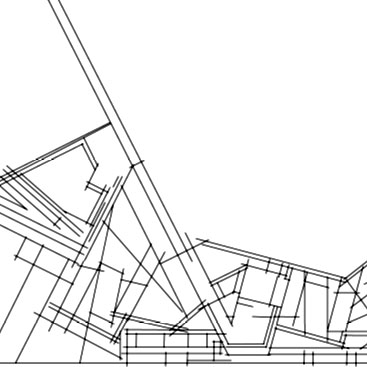

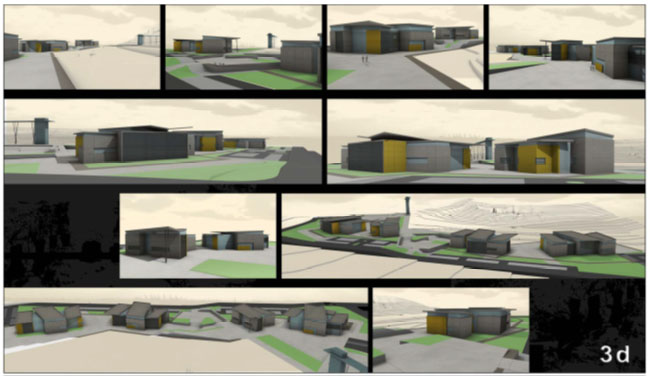

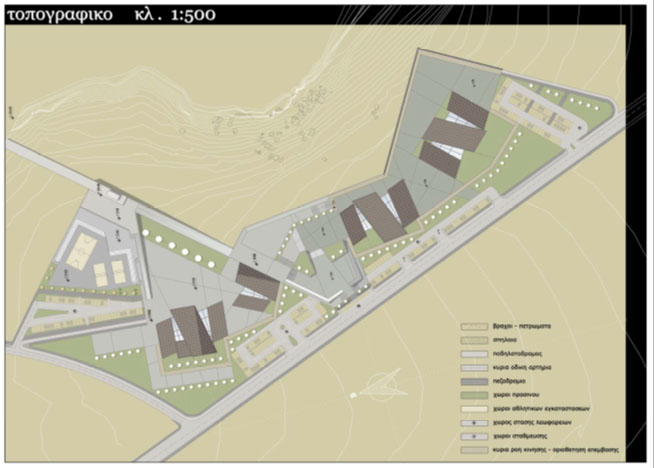





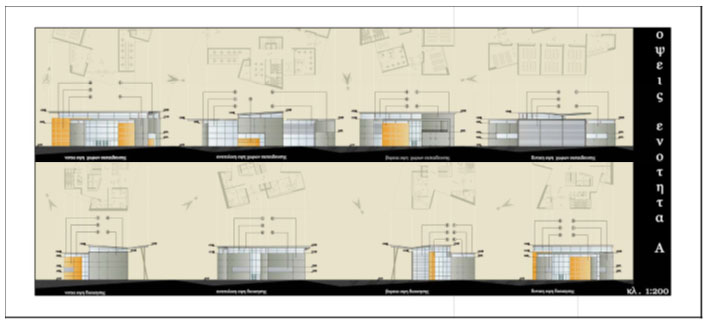

The subject matter of the diplomatic study concerns the design and creation of the University structures and facilities in the department of the architects school in the city of Pafos. The necessity of restructuring and upgrading the sector of education in the specific area was the decisive factor in the choice of the subject matter, which will result to the strengthening and reformation of the education and culture of the local society in general.
As a hint and starting point in the choice of the subject was the obvious lack of educational centers of the highest level due to the fact that the main activity of the people of Pafos is the agriculture and tourism. The aim of the study is to shape four territorial units which converse with the landscape and function simultaneously as autonomous and independent spaces (locations) separating and categorizing their functions and operations in two separate unities. The first unity refers to the administration and education and a second unity to the research and culture. In the first unity the functions and operations concerning the organization of the architectural department and carrying out of the schedule (program) of the students studies are incorporated. In the second unity the library building and the exhibition area are incorporated, aiming to encourage the research of the knowledge and the presentation of the actual results of the said knowledge.
The plot on which the university buildings, installations and facilities will be built is within the region of the Yeroskipou municipality north-east of Pafos and consists the first part of the three elevations of the ground which was created during the geological years from the level of the sea, thus creating the existing topiography. Basic criterion in the choice of the location was the inclusion of the education buildings in the urban network of the city, having easy accessibility from any point of the area, and the gathering of symbolism and memories from the remains which witnesses the cultural and geological history of the area. The plot lies in the lower part of a sharp hypsometric (altitude) of about 23 meters, which practically disconnects the accessibility towards the built area of Yeroskipou and embraced by the city of Pafos in the north-west part creating a relativity between them. The extend of the plot is over 1000 donums. A special plan of development has already been designed for the said plot and combines projects such as hospital, medical centers, athletic installations, research centers, schools, residential and commercial units, shopping center and parks.
The linear continuation of the area between the two sectors (Yeroskipou-Plot) is interrupted by the steep hypsometric difference which becomes a natural boundary thus obstructing the direct access to the project, therefore the building of a pedestrian bridge which connects the project with the roads network leading to the points of reference within the city and in the proposed central square (piazza) which unifies the two functional and operational unities of the architectural school.
The natural division limit finally worked out in a different way in this case, since it placed at the same time the direction line in the continuous successive arrangement of the area units following the topiography of the area in a horizontal axis. The combination of the topiography by using a system of conceivable mappings that results out of the streets and which the limits the spaces and shapes of the rules and principles of designing. As a final result a shape and design of the buildings comes out through an analysis procedure by deeping into the elements and characteristics of the area and its history.
Supervisor: Papadopoulos Spiros
Reference Number: 199


Throughout history and up till now, man inhabited his land with the company and presence of his domestic animals that existed always next to him. In modern cities, however, it is really difficult for anyone to keep his beloved dog or cat, needless to mention in that sense his horse and whoever does keep an animal next to him is forced to suppress it into the asphyxiating environment of the modern industrial city. As a result, in order man to satisfy his need of contact with nature, he is adjusting it to the existing urban setting via gardens and parks placed into his own surroundings. In the survey we are about to examine, first and premium place has the expression of the natural environment through a park equally hospitable for men and for their domestic animals placed in the greater area of the city of Kozani.
The creation of a park is suggested, in which horses and dogs will be hosted and people will have the ability to come in touch with nature, enjoy themselves and relax in a natural setting along with their pet or even on their own, when the presence of nature is most missed and needed. Moreover, certain and specific area will exist suited for exposition and shows of ecological and traditional interest, similar festivals and celebrations and capable of hosting furthermore lectures and film festivals of such interest and the perfect place in the end for school excursions, in order for children to learn from early age the culture and coexistence throughout the ages of man and animal in natural agricultural environment and have the chance to familiarize with that certain surrounding.
In the park an equestrian club exists, which includes the stables for the hosting and stay of horses, a round training field and four paddocks best suited for the everyday practice of the horses. Also a big racing track will be included and a warm-up paddock as well. In the great area of the club are placed furthermore the lockers and changing rooms for the employees and everyone else involved with horses and also a smaller area used and existing for the horse fans as a gathering point.
Besides the equestrian club inside the park functions a modern kennel club also areas in which dogs will be hosted temporarily in single- built kennels with small private garden and yard specially designed for the everyday needs of the animals. Apart from that a big bushy fenced surrounding exists in which dogs will be let loosed without the danger of escaping their owner’s attention. This particular area is divided with a natural fraction into two separate parts in order for smaller to be kept aside from bigger ones, for safety reasons.
Moreover, as a pole of attraction for all who don’t own a pet, a cafeteria will function, where visitors can enjoy the natural beauty of the area with sight to the small artificial lake and to the race tracks and paddocks.
Ending, certain routes and paths will place and follow all activities. Those routes will be sometimes filled with beautifying trees, flowers and bushes surrounding the areas and in other cases due to the functionality and cause of existence of particular parts will have open sight to more distant tree rows. In all buildings, surrounding and routes a composition of natural materials and textures will be used to describe the physical site and its interaction with the buildings and all the artificial interventions.
Supervisor: Giannisi Phoebe
Reference Number: 197
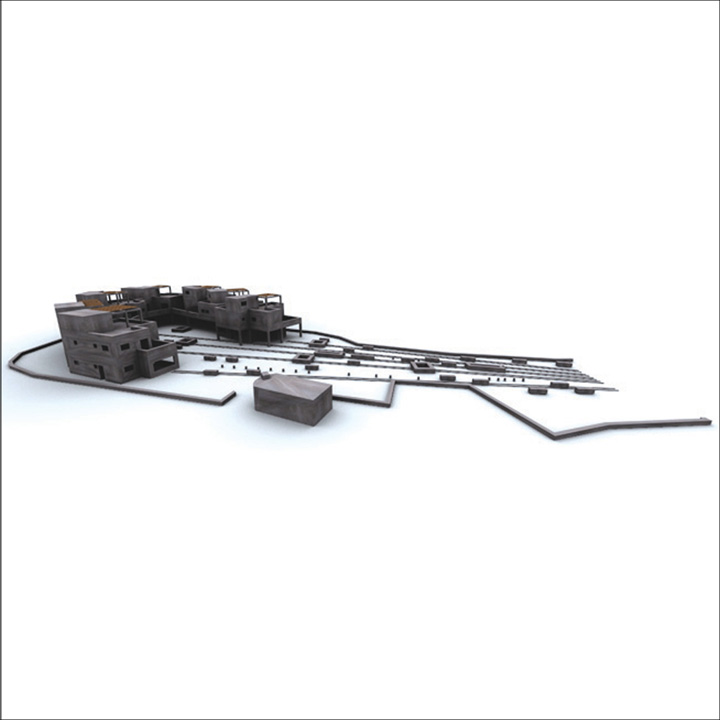

Subject of the diploma project is the creation of complex cottages at the built up area of Lefokastro which is at the east side of Pilio Mountain. At the diploma project it has be done an attempt to create a complex which would converse the cottages and create a small settlement. When I was trying to read out and understand the area I realized that wanted to create a construction that would making a contrast between the classic and modern architecture. Always I was thinking that the complex is the manifold of many elements I tried to create this but I also wanted to show a free way of planning and drawing with severe capacities and how the functionality converses with the pattern of the buildings. From the beginning I wanted to place the buildings at the perimeter of the building ground so the buildings will create a centre square which will constitute the public area of the complex. So in that way we have a shape like a petal which is going to break down and so we have the first form of the cottage. The form of ground floor is the same for all the houses but at the first floor I rotated the ground floor so I created the balconies and the first shape of the first floor. The shape of first floor of each house transform from house to another so we have multiformity and a complication which leads us to the unifying multiformity. Every first floor lays down to its near ground floor and that leads to a continue building. Under the unit has been created an underground parking to avoid the view of car in the complex of cottages and every house is come throw from the inside to the parking. The outside area which leads straight to the centre square was created by some striations and some secants on them. Every walking road is from a different material so the outside area is connected with the whole complex of cottages.
Supervisors: Stylidis Iordanis, Tzirtzilakis Yorgos
Reference Number: 179
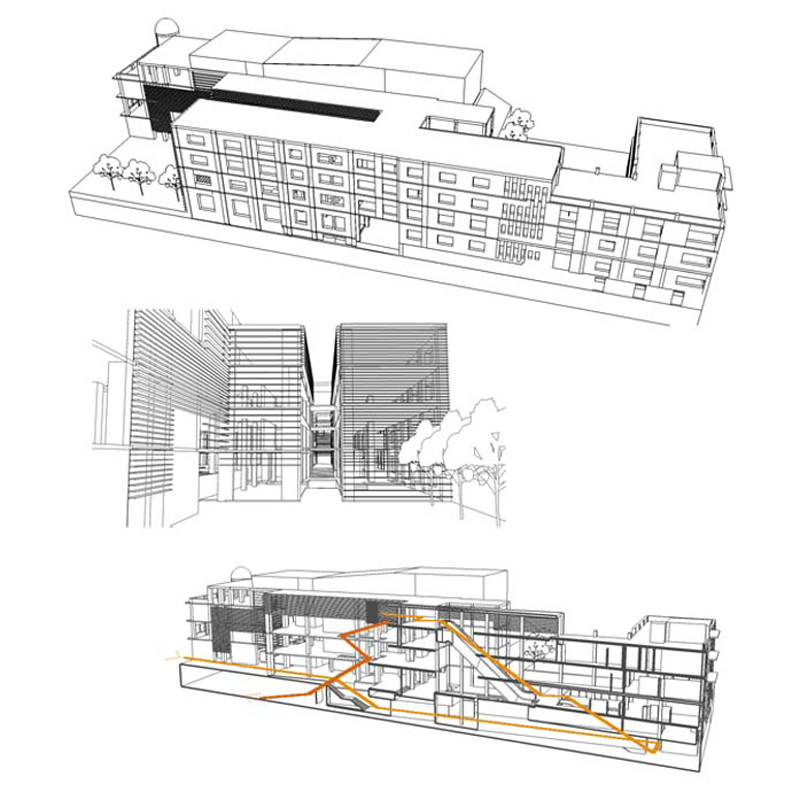

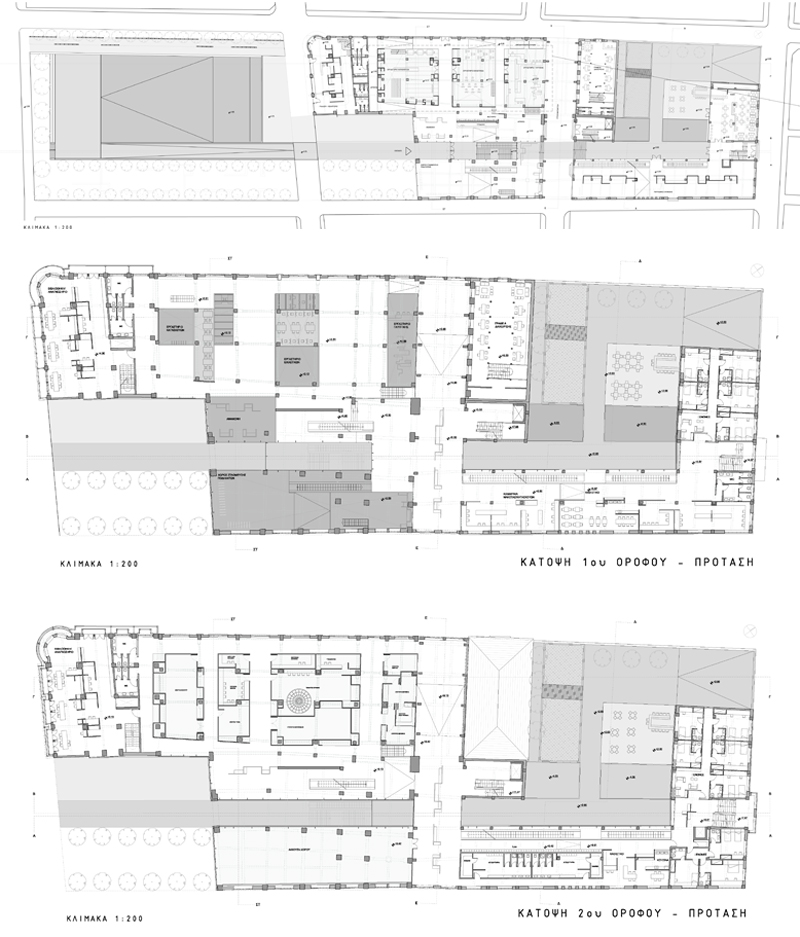

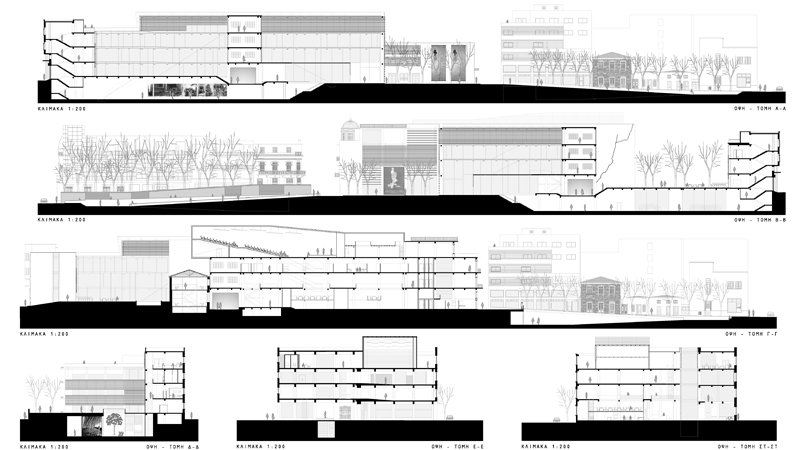

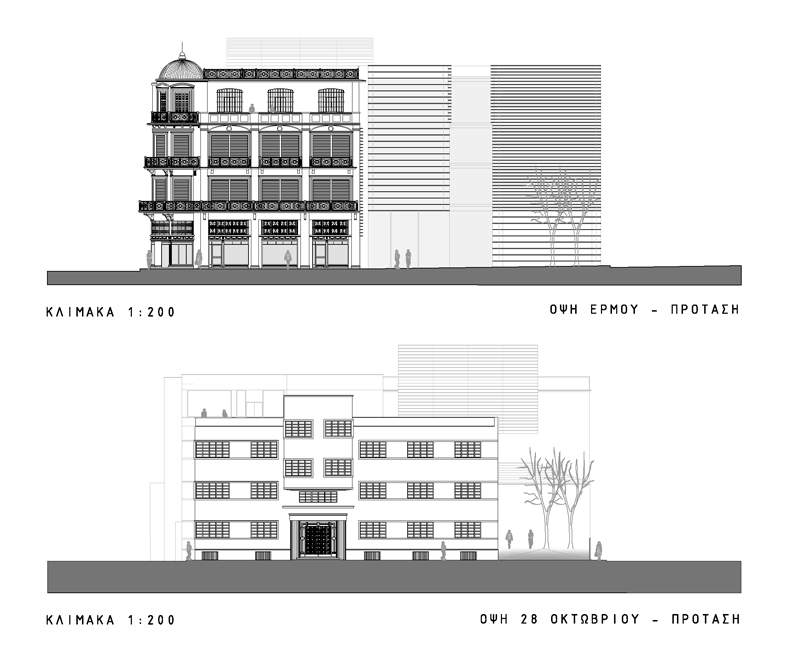

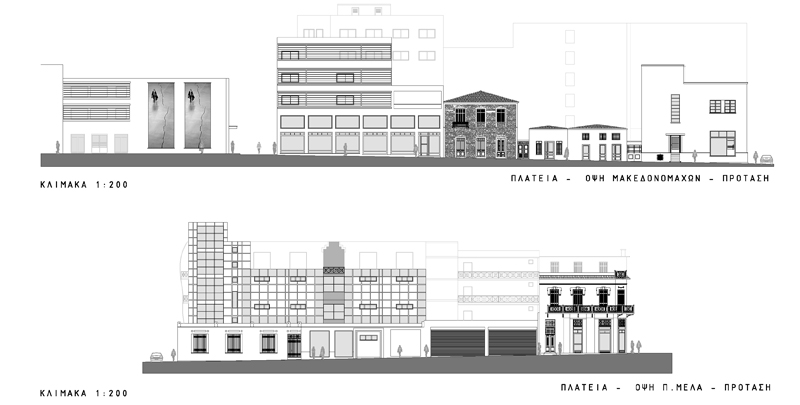

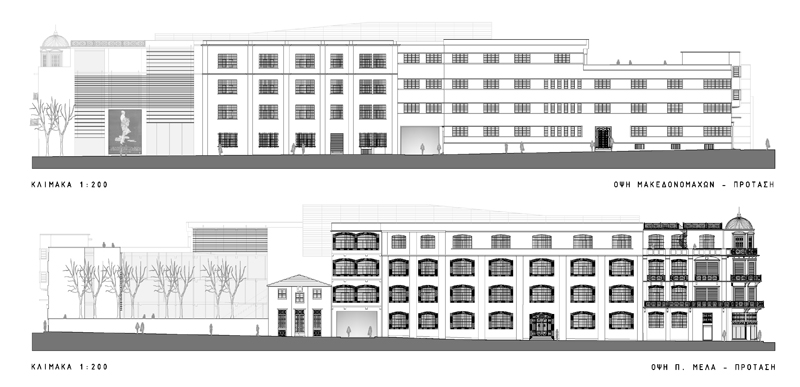

The building complex of Matsagos belongs to the University of Thessaly and it is situated in the centre of the town-planning tissue of the city of Volos and constitutes a reference place for the local community and its size allows multiple activities.For all these reasons, we decided the reuse of the complex as a place which is addressed to the creative and artistic needs of the students, which is simultaneously open to the public of Volos in a more vivid and conciliatory relationship between the University and thecity.
The building programme includes workshop, exhibition and manifestation spaces, banquet and hospitality spaces as well as spaces of artistic activities, converting the Matsagos complex into a powerful pole of attraction.
The building complex was developed in four phases. The continuous and gradual expansion has as a result a “matching” of buildings with different morphological and territorial particularities. The sights of the complex are preservable as well as the Matsagos arcade.
We are aiming at unifying and modulating the outdoor spaces of the complex, which include the university square, to the beautiful blocks, through a unified gesture preserving the arcade at the same time.
Thus, we decided to make a “surgical” section to the building creating an intermediate space between the two produced “new pieces” of the building. The necessity of preservance of the arcade led us to the design of a course which passes underneath it and to the space defining of the public places to the end levels of the building. These spaces are unified with an uninterrupted ascent to the limit of the section while the descent is fulfilled gradually through the intermediate floors which are characterised by a bigger level of privatisation.
With the “surgical section”, the interior of the building with the existing hemp of the organization, acquires elements of exterior space. The section becomes the sight and functions as an element of orientation. The meaning of this sight is enhanced as it is charged as an “epidermis” with its own character which organizes the movement to its limits.
Epidermes with different expressions (sight, walls, separated panel, furniture) “include” movements and define spaces. They respectively define levels of privatization and inwardeness in relation to the movement of the human body, the use of the space and the level of transparency of their materials.
The prearranged movement course of the human body in the space organizes the form and the functions of the building and vice versa; the way in which the space is structured is reflected to the way of movement inside it.
The “recess” of the building is expanded as engraving and as a ramp to the square, which “descends” gradually in order to create an open stage and functions as an open space in which the public converses – in a unified sense – with the new character of the building complex.
Supervisors: Colonas Vassilios, Gavrilou Evelyn
Reference Number: 175


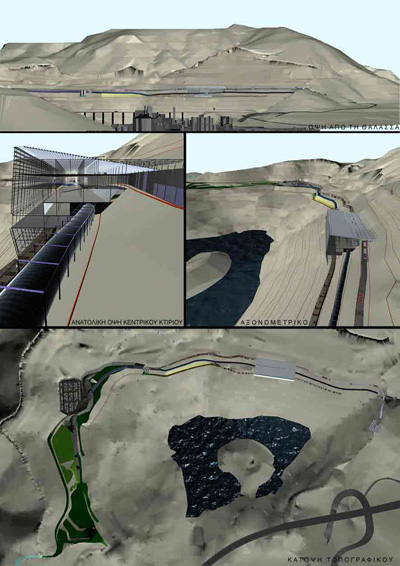

At the dawn of the 20th century, right after the devastating Asia Minor military campaign, Greece was being reconstructed based on reinforced concrete, a total novelty back then, which was easy to manufacture due to the abundancy of limestone in the country. “AYET Heracles” has been engaged in cement production in the area of Volos since 1924, extracting ore from the adjacent mount Pelion and has developed rapidly after a leap in demand that arose from social situations in the ’50s. Nevertheless, this growth was recenlty put a limit to not so long ago, because of the reactions of the residents in the vicinity against the intense pollution of the industry, thus leading to AYET’s cease of excavation. The factory switched to getting its ore via sea ways and planted trees in its quarry in order to appease turbulent spirits. Nowadays, the popular demand for a permanent relocation of the industry away from residential areas is increasingly discussed; such a move, however, does not include the quarry which is now promoted to an importand landmark as a result of the construction of the new Volos Ring Road which crosses through the dig’s outskirts.
Our study explores ways of rehabilitation of the quarry as a place of recreation – both through creative activity and artistic functions (AYET has always been interested in art and its prominent contemporary disciples, owning a numerous collection of works of art by comission), as well as a locus for learning and enlightment, literally and in metaphore. Our suggestion is based upon four fundamental intentions: (a) total employment of the quarry, (b) preservation of the landscape, (c) lineal order of the new structures as a point of reference to the factory’s production line and (d) interactive enagagement of the users to the function of spaces. All is built with metal and glass, the cube being the main constructive unit, on an axis of three routes on three different levels of the quarry that define three zones of different use: museum (a), recreation – transportation (b) and learning (c). On three nodal points across this axis occur three buildings: reception and briefing (1), learning, hospitality, creation and recreation (2) and restaurant/bar (3). The layout of the buildings in several niveaus brings a rupture of the compact metal front while endowing the project with a dynamic visual focus in the surrounding area. The lighing of both the factory plant and the new construction with various colours visually illustrates the industry’s evolution phases as well as the relation between parts of the two.
Our whole study aims at reconciling the city with the industrial site and at re-incorporating it in urban activity.
Supervisor: Colonas Vassilios
Reference Number: 188

